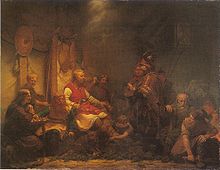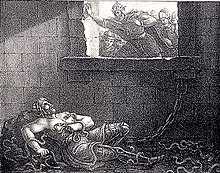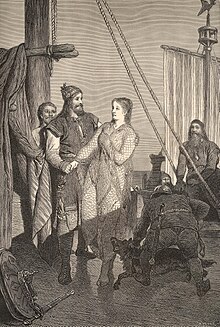Ragnar Lodbrok
Ragnar Lodbrok ( Regner Lothbrog , Latinized Regnerus , Old Norse Ragnarr Loðbrók ) was a Viking and king in Denmark who is said to have lived in the early 9th century. He is a hero in the Norse prehistoric saga ( fornaldarsaga ) and is said to have been the father of Sigurd, Björn , Hálfdan , Ivar and Ubba Ragnarsson , among others . However, the historical existence of Ragnar is disputed in research.
The historical Ragnar
Few facts are known about the historic Ragnar Lodbrok; its very existence is by no means certain. Ragnar and Lodbrok may even be two different people who were only mixed up in later tradition.
Historically certain for the period in question (1st half of the 9th century) is a Viking leader who attacked Paris in western France in 845 . In Franconian sources he is mentioned by name as Reginheri . He is often equated with Ragnar Lodbrok, although this identification is sometimes controversial in research. Reginheri , however, is likely to represent the historical core for the figure of Ragnar Lodbrok in the later Nordic saga literature. Attempts to equate Ragnar with a Viking leader mentioned in Irish annals are more problematic. If so, it must have been before 845, because according to the annals of Xanten , Reginheri died shortly after the raid of 845 and could therefore no longer have been active in Ireland later.
In the Anglo-Saxon Chronicle and in Irish annals, Ivar Ragnarsson , allegedly a son of Ragnar, appears as an important Viking leader. Father and son appear as legendary hero figures in Nordic saga literature. However, it is by no means certain that Ivar and his brothers were in fact the sons of a historical Ragnar.
Ragnar in Norse lore
overview
In the Icelandic Ragnars saga lodbrokar , Ragnar appears as the son of distinguished descent from Denmark. There and at Saxo Grammaticus (Book 9 of the Gesta Danorum ) the nickname Lodbrok means " loden trousers " and refers to the clothing that Ragnar put on when fighting a kind of dragon to protect himself from poisonous bites. He slays the lindworm - two gigantic venomous snakes near Saxo - which increases his fame. He eventually becomes a powerful king in Denmark himself. Both in Saxo and in the saga, Ragnar dies in the snake pit of the Northumbrian king Ælle ( Elli or Hella ).
However, Rory McTurk has pointed out that the name Lodbrok may have referred to a female person (Lodbroka) and only later was erroneously referred to a historical Ragnar (the Viking guide mentioned above). According to this, Ragnar Lodbrok would not be a historically existing person, but the result of a mixture of different narratives in the following tradition, which would also explain many contradictions.
Ragnar's women
At Saxo Grammaticus, Ragnar marries three times: first Lathgertha , then Thora and finally Suanlogha. Lathgertha's most noticeable traits are her martial skills and her splendid long hair. She is the mother of her son Fridlevus, who does not play a major role, and two daughters whose names are not mentioned. Ragnar leaves Lathgertha in favor of Torah.
Ragnar's wife Suanlogha also only appears in Saxo's version. She is Ragnar's third wife after Lathgertha and Thora, plays only a minor role and is only mentioned twice. At Saxo she is the mother of Regnaldus, Vithsercus and Ericus, all three of whom also appear in the saga. Perhaps there is a connection between Suanlogha and Ragnar's wife Aslaug that does not appear in Saxo. Ragnar's wife, Torah, appears in both Saxo and the saga. Their representation is largely the same in both versions.
Aslaug, nicknamed Kráka (Icelandic "crow"), is Ragnar's second wife after Torah in the Ragnar saga. Aslaug is the real main character in the Ragnar saga. In the Ragnar saga as well as the Völsunga saga , she is the daughter of the dragon slayer Sigurd (Sigurdh) and Brynhild , but grew up with Heimir in Hlindalir. She becomes pregnant by Ragnar and gives birth to a boy who, like the Völsungen, bears the mark of a lindworm in his eyes (snake in the eye) , which is why he is named Sigurd (h) after Aslaug's father. So everyone knew that Aslaug was really Sigurd and Brynhild's daughter.
Ragnar's sons

Eirekr is the son of Torah in the saga, and Suanlogha in Saxo.
Björn is Aslaug's son in the saga, and Suanloghas in Saxo.
Sigurd snake eye, whose nickname was wrongly interpreted as a snake-shaped scar around one eye, is meant, however, that he had the piercing gaze of a snake. This look is a hallmark of the bulges that Sigurd shares with Aslaug's half-sister Svanhild, for example.
Ivar is mentioned in the saga as the son of Ragnar and Aslaug. It is also called "beinlauss", "boneless" or "legless". In connection with Ivar's nickname, Rory McTurk points out that it may be misinterpreted. "Boneless" is a term for wind in some Norwegian stories, so Ivar's ability as a navigator can be meant.
Hvitserk was called the son of Ragnar by Saxo. He ruled over the principality of Hellespont, probably on the Gulf of Riga. The Ragnars saga loðbrókar names him as one of four sons of Ragnar and Aslaug. He is said to have ruled over Reidagotland (Jutland) and Wendland (Slavic area) after his father's death.
Ubba and Halfdan are mentioned as other sons of Ragnar.
Adaptation in literature and film
Ragnar Lodbrok is the main character in Edison Marshall's 1951 novel The Viking , which was filmed in 1958 by director Richard Fleischer based on a script by Dale Wasserman and Calder Willingham under the title The Vikings (German: The Vikings ). The role of Ragnar is played here by Ernest Borgnine . Ragnar Lodbrok, played by Travis Fimmel , is also the focus of the Canadian-Irish television series Vikings from 2013 , although numerous fictional elements are incorporated. The Hammer and Cross novel trilogy by Harry Harrison and John Holm begins with Ragnar's execution in the snake pit.
- Anglo-Saxon Chronicle , Annals, 9th Century
- Ragnarsdrápa , skald poem , 9th century
- Krákumál , Scottish skald poem, 12th century, about Ragnar's death
- Saxo Grammaticus : Gesta Danorum , Book IX, 12th century, in: Paul Herrmann (Ed.): Explanations of the first nine books of the Danish history of Saxo Grammaticus. First part, translation . Published by Wilhelm Engelmann, Leipzig 1901 ( on Archive.org ).
- Ragnarssona þáttr (story of Ragnar's sons), Icelandic saga , 13th century, in: Friedrich Heinrich von der Hagen (editor, translator): Ragnar-Lodbroks-Saga and Norna-Gests-Saga . Verlag Joseph Max and Komp., Breslau 1828. Part 1: Saga of Ragnar Lodbrok and his sons . Translation by: Ragnars saga Loðbrókar . ( Preview in Google Book Search)
- Ragnars saga loðbrókar (saga of Ragnar Lodbrok), Icelandic saga, 13th century, in: Paul Herrmann, Ulf Diedrichs (ed.): Nordic Nibelungen: the sagas of the Völsungen, by Ragnar Lodbrok and Hrolf Kraki . Eugen Diederichs Verlag, Cologne 1993.
literature
- Rory McTurk: Studies in "Ragnars saga loðbrókar" and Its Major Scandinavian Analogues. Oxford 1991.
- Rory McTurk: Ragnarr Lodbrok in the Irish Annals? In: Proceedings of the Seventh Viking Congress. Dublin 1976, pp. 93-123.
- Elizabeth Ashman Rowe: Vikings in the West. The Legend of Ragnarr Loðbrók and His Sons. Vienna 2012.
Web links
- Gesta Danorum, Liber 9, Caput 3 in the Latin original (on Ragnar, here Regnerus , click on chapter by chapter)
- Explanations of the first nine books of the Danish history of the Saxo Grammaticus, Part I, Books VI – IX - German translation on Wikisource (on Ragnar, here Regner , see ninth book)
- Ragnars saga Loðbrókar in the Icelandic original
Remarks
- ↑ Jackson Crawford: The Saga of the Volsungs: With the Saga of Ragnar Lothbrok, ISBN 978-1-62466633-9
- ↑ Cf. Rory McTurk: Ragnarr Lodbrok in the Irish Annals? In: Proceedings of the Seventh Viking Congress. Dublin 1976, p. 94.
- ↑ Cf. Rory McTurk: Ragnarr Lodbrok in the Irish Annals? In: Proceedings of the Seventh Viking Congress. Dublin 1976, pp. 93ff.
- ↑ Marios Costambeys: Ívarr [Ívarr inn Beinlausi]. In: Oxford Dictionary of National Biography . Vol. 29 (2004), pp. 443-445.
- ↑ See generally Rory McTurk: Ragnarr Lodbrok in the Irish Annals? In: Proceedings of the Seventh Viking Congress. Dublin 1976, pp. 121f.
- ^ Friedrich Heinrich von der Hagen (Ed.), 1828: Ragnar-Lodbroks-Saga , pp. 6-8.
- ↑ Gesta Danorum 9.4.8 (p. 253,10). (1) Cuius cultum rex curiosius contemplatus, cum hirtum atque hispidum animadvertisset, praecipue tamen occiduae vestis horrorem maximeque incomptam braccarum speciem eludens, Lothbrog eum per ludibrium agnominavit.
- ↑ Friedrich Heinrich von der Hagen (Ed.), 1828: Ragnar-Lodbroks-Saga , p. 80f.
- ↑ Gesta Danorum 04/09/38 (p. 262.7). (3) Comprehensus enim atque in carcerem coniectus, noxios artus colubris consumendos advertit atque ex viscerum suorum fibris tristem viperis alimoniam praebuit.
- ↑ Cf. Rory McTurk: Studies in "Ragnars saga loðbrókar" and Its Major Scandinavian Analogues. Oxford 1991, p. 23ff.
- ↑ Gesta Danorum 9.4.2 - 9.4.3
- ↑ Gesta Danorum 9.4.4
- ↑ Gesta Danorum 04.09.17, 09.04.34
- ↑ Gesta Danorum 9.4.4, 9.4.13, 9.4.20
- ↑ Friedrich Heinrich von der Hagen (Ed.), 1828: Ragnar-Lodbroks-Saga , pp. 3, 8, 12, 13, 17, 23, 24.
- ↑ Friedrich Heinrich von der Hagen (Ed.), 1828: Ragnar-Lodbroks-Saga , pp. 15–28, 37f., 50–59, 73–79.
- ^ Friedrich Heinrich von der Hagen (Ed.), 1828: Ragnar-Lodbroks-Saga , p. 39.
- ↑ The Saga of the Völsungen - Part 8 . Thule - Old Norse Seals and Prose, Volume 21 - Icelandic Heroes Novels. ( Online at Manfrieds Trelleborg Niewergin , Manfred Lohmann.)
- ^ Snorri Sturluson : The Niflungs and Giukungen . Translation by Karl Joseph Simrock. ( Online at Manfrieds Trelleborg Niewergin , Manfred Lohmann.)
- ↑ Friedrich Heinrich von der Hagen (Ed.), 1828: Ragnar-Lodbroks-Saga , p. 41f.
- ^ Rory McTurk: Studies in "Ragnars saga loðbrókar" and Its Major Scandinavian Analogues. Oxford 1991, pp. 40f.
- ^ Edison Marshall: The Viking . Farrar, Straus and Young, New York 1951, 380 pages (English).
| personal data | |
|---|---|
| SURNAME | Ragnar Lodbrok |
| ALTERNATIVE NAMES | Ragnarr Loðbrók |
| BRIEF DESCRIPTION | Danish and Swedish king |
| DATE OF BIRTH | 8th century or 9th century |
| DATE OF DEATH | 845 |

